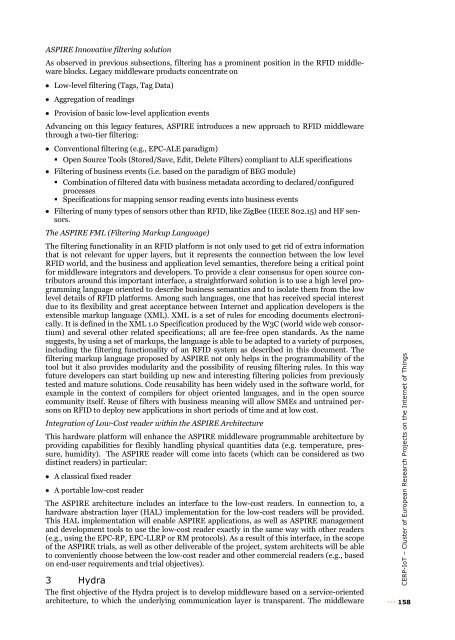Vision and Challenges for Realising the Internet of Things
Vision and Challenges for Realising the Internet of Things
Vision and Challenges for Realising the Internet of Things
You also want an ePaper? Increase the reach of your titles
YUMPU automatically turns print PDFs into web optimized ePapers that Google loves.
ASPIRE Innovative filtering solution<br />
As observed in previous subsections, filtering has a prominent position in <strong>the</strong> RFID middleware<br />
blocks. Legacy middleware products concentrate on<br />
Low-level filtering (Tags, Tag Data)<br />
Aggregation <strong>of</strong> readings<br />
Provision <strong>of</strong> basic low-level application events<br />
Advancing on this legacy features, ASPIRE introduces a new approach to RFID middleware<br />
through a two-tier filtering:<br />
Conventional filtering (e.g., EPC-ALE paradigm)<br />
Open Source Tools (Stored/Save, Edit, Delete Filters) compliant to ALE specifications<br />
Filtering <strong>of</strong> business events (i.e. based on <strong>the</strong> paradigm <strong>of</strong> BEG module)<br />
Combination <strong>of</strong> filtered data with business metadata according to declared/configured<br />
processes<br />
Specifications <strong>for</strong> mapping sensor reading events into business events<br />
Filtering <strong>of</strong> many types <strong>of</strong> sensors o<strong>the</strong>r than RFID, like ZigBee (IEEE 802.15) <strong>and</strong> HF sensors.<br />
The ASPIRE FML (Filtering Markup Language)<br />
The filtering functionality in an RFID plat<strong>for</strong>m is not only used to get rid <strong>of</strong> extra in<strong>for</strong>mation<br />
that is not relevant <strong>for</strong> upper layers, but it represents <strong>the</strong> connection between <strong>the</strong> low level<br />
RFID world, <strong>and</strong> <strong>the</strong> business <strong>and</strong> application level semantics, <strong>the</strong>re<strong>for</strong>e being a critical point<br />
<strong>for</strong> middleware integrators <strong>and</strong> developers. To provide a clear consensus <strong>for</strong> open source contributors<br />
around this important interface, a straight<strong>for</strong>ward solution is to use a high level programming<br />
language oriented to describe business semantics <strong>and</strong> to isolate <strong>the</strong>m from <strong>the</strong> low<br />
level details <strong>of</strong> RFID plat<strong>for</strong>ms. Among such languages, one that has received special interest<br />
due to its flexibility <strong>and</strong> great acceptance between <strong>Internet</strong> <strong>and</strong> application developers is <strong>the</strong><br />
extensible markup language (XML). XML is a set <strong>of</strong> rules <strong>for</strong> encoding documents electronically.<br />
It is defined in <strong>the</strong> XML 1.0 Specification produced by <strong>the</strong> W3C (world wide web consortium)<br />
<strong>and</strong> several o<strong>the</strong>r related specifications; all are fee-free open st<strong>and</strong>ards. As <strong>the</strong> name<br />
suggests, by using a set <strong>of</strong> markups, <strong>the</strong> language is able to be adapted to a variety <strong>of</strong> purposes,<br />
including <strong>the</strong> filtering functionality <strong>of</strong> an RFID system as described in this document. The<br />
filtering markup language proposed by ASPIRE not only helps in <strong>the</strong> programmability <strong>of</strong> <strong>the</strong><br />
tool but it also provides modularity <strong>and</strong> <strong>the</strong> possibility <strong>of</strong> reusing filtering rules. In this way<br />
future developers can start building up new <strong>and</strong> interesting filtering policies from previously<br />
tested <strong>and</strong> mature solutions. Code reusability has been widely used in <strong>the</strong> s<strong>of</strong>tware world, <strong>for</strong><br />
example in <strong>the</strong> context <strong>of</strong> compilers <strong>for</strong> object oriented languages, <strong>and</strong> in <strong>the</strong> open source<br />
community itself. Reuse <strong>of</strong> filters with business meaning will allow SMEs <strong>and</strong> untrained persons<br />
on RFID to deploy new applications in short periods <strong>of</strong> time <strong>and</strong> at low cost.<br />
Integration <strong>of</strong> Low-Cost reader within <strong>the</strong> ASPIRE Architecture<br />
This hardware plat<strong>for</strong>m will enhance <strong>the</strong> ASPIRE middleware programmable architecture by<br />
providing capabilities <strong>for</strong> flexibly h<strong>and</strong>ling physical quantities data (e.g. temperature, pressure,<br />
humidity). The ASPIRE reader will come into facets (which can be considered as two<br />
distinct readers) in particular:<br />
A classical fixed reader<br />
A portable low-cost reader<br />
The ASPIRE architecture includes an interface to <strong>the</strong> low-cost readers. In connection to, a<br />
hardware abstraction layer (HAL) implementation <strong>for</strong> <strong>the</strong> low-cost readers will be provided.<br />
This HAL implementation will enable ASPIRE applications, as well as ASPIRE management<br />
<strong>and</strong> development tools to use <strong>the</strong> low-cost reader exactly in <strong>the</strong> same way with o<strong>the</strong>r readers<br />
(e.g., using <strong>the</strong> EPC-RP, EPC-LLRP or RM protocols). As a result <strong>of</strong> this interface, in <strong>the</strong> scope<br />
<strong>of</strong> <strong>the</strong> ASPIRE trials, as well as o<strong>the</strong>r deliverable <strong>of</strong> <strong>the</strong> project, system architects will be able<br />
to conveniently choose between <strong>the</strong> low-cost reader <strong>and</strong> o<strong>the</strong>r commercial readers (e.g., based<br />
on end-user requirements <strong>and</strong> trial objectives).<br />
3 Hydra<br />
The first objective <strong>of</strong> <strong>the</strong> Hydra project is to develop middleware based on a service-oriented<br />
architecture, to which <strong>the</strong> underlying communication layer is transparent. The middleware<br />
CERP-IoT – Cluster <strong>of</strong> European Research Projects on <strong>the</strong> <strong>Internet</strong> <strong>of</strong> <strong>Things</strong><br />
158
















